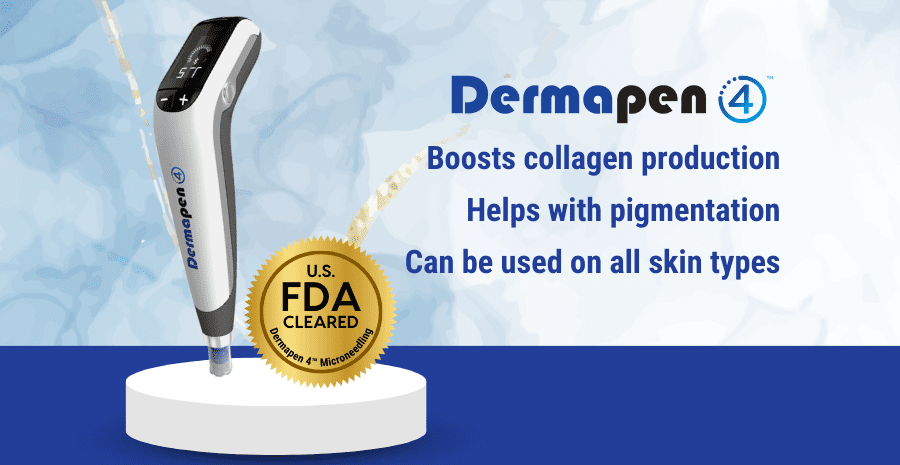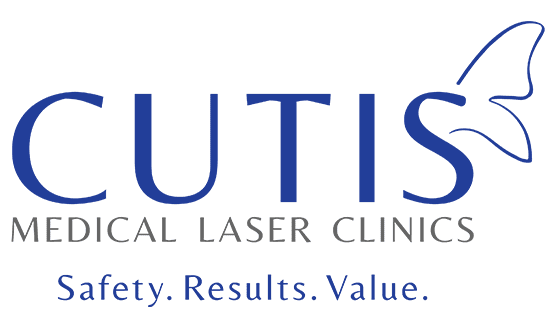
Microneedling, also known as Collagen Induction Therapy (CIT) is a minimally invasive treatment that can improve the texture and overall appearance of your skin. It causes micro-trauma to the skin, often enough to prompt an immune response that leads to the production of collagen.
What is microneedling via Dermapen 4?
Dermapen 4 is an automated microneedling device that holds a European CE mark approval. It is also US FDA-cleared for reducing the appearance of facial acne scars. Providing a needle penetration of up to 3.00mm, it can target different types of scars, such as rolling, box, and ice pick scars. It also has a dedicated scar setting and protocols for revision of deep and atrophic scars.
Skin needling via Dermapen 4 features 16 microscopic needles that mechanically and vertically pierce the skin. The device quickly creates millions of fine fractional channels that can carry up to 80% more nutrients deeper into the skin. The micro-injuries also trigger a natural repair response in the body that ignites collagen and elastin.
The production of essential skin proteins helps repair the skin surface layer and treat a number of issues, giving the skin a more rejuvenated appearance. The inflicted micro-trauma allows the skin to spend more time combatting the ailments, which then improves its overall quality.
How does Dermapen 4 microneedling work?
The procedure uses an automated pen-like device, called Dermapen 4, with 16 microscopic needles. These pierce the skin in a controlled manner, creating tiny holes that lead to micro-damage. It causes the body to think there is a wound in the area, which then activates the immune system and skin’s healing function.
The body then disinfects the wound created by the microneedling. This removes the debris, while also increasing blood flow and providing nutrients to the area. Then, the body will begin the process of creating new tissue, which will help combat skin ailments. There is also increased collagen and elastin, providing strength and elasticity to the skin.
Note: Microneedling using Dermapen 4 is not the same as using a derma roller. The latter is manually powered, which may sometimes lead to scarring or damage when used incorrectly or when the wrong needle size is used. Derma rollers, furthermore, are not as consistent and versatile as microneedling devices.
TREATMENTS
- Anti-Aging- Dermapen treatments help ignite natural collagen and elastin production to repair the surface layers of the skin. This results in healthier skin that looks brighter, tighter, and more even toned with refined pores and reduced wrinkles.
- Scarring - Dermapen 4 has a dedicated scar setting and protocols for revision of deep, atrophic scars; including surgical, burn contracture, striae, and post-acne scars. There is also no dragging or pulling of the skin.
- Pigmentation- Dermapen removes the risk of heat injury and hypopigmentation risks, while promoting optimized cell function. This makes it a suitable procedure for any patient affected by melasma and with a predisposition to hyperpigmentation.
Elevating Dermapen Procedures
DERMAPEN MG-Collection™
The Dermapen MG (Meso-Glide) Collection is a range of serums exclusively designed for skin needling. It features a combination of skin technologies and sterile active ingredients to elevate the results of your Dermapen 4 treatment.
Here are the 5 formulations in the MG-Collection range of serums:
- MG-HA35 – Restores, refreshes, and enhances the skin’s appearance. It also contains zinc for better skin repair and vitamin B5 to soothe, heal, and regenerate skin.
- MG-HA35+ – Hydrates skin and improves visible signs of aging. It features the enhanced telomeres technology – GGP that helps prolong the life of a cell to reduce the visible effects of aging.
- MG-BL – Brightens and lightens uneven skin tone. It has ingredients that can help slow melanin production to reduce the appearance of unwanted pigmentation.
- MG-CLR – Helps clear skin and address problematic skin concerns (acne, comedones, open pores, and oily skin). It contains anti-inflammatories to help calm and soothe skin, as well as stimulate collagen to improve the look of lines and wrinkles.
- MG-R.A.S. – Helps reverse the signs of aging and scars. It has a powerful blend of beneficial ingredients to reduce discoloration, rough skin, fine lines, and wrinkles.
Meso-Glide serums at work
The makers of Dermapen MG Collection understand that no skin is the same and will therefore require different treatments. The serums help create a personalized treatment based on the patient’s skin concerns. They can be infused topically into the skin during a Dermapen skin needling treatment or be combined with other formulations, depending on skin care needs and conditions.
EXO-SKIN EXOSOMES
Exo-Skin Exosomes are ethically derived from a multipotent and pure source. They are special formulations that complement microneedling procedures and help take them to the next level. At Cutis, we have the MG-EXO-SKIN™ (used as a glide in Dermapen 4 procedures) and EXO-SKIN™ (used as a part of daily home care protocol).
- MG-EXO-SKIN – used in in-clinic regenerative procedures, as well as professional microneedling. The use of the Dermapen 4 device enables the regenerative capabilities of exosomes to speed up the results of the treatment. It can also improve different skin conditions such as:
- Rosacea
- Sun damage
- Aging
- Pigmentation
- EXO-SKIN – used at home to improve the results of in-office or professional treatments. This rejuvenating serum is recommended to be used twice a day, morning and night, for post-op and ongoing homecare. Regular use enhances the results of microneedling with the potent actives of MG-EXO-SKIN.
Benefits of EXO SKIN™ EXOSOMES:
- Maximized potential for skin regeneration
- Boost natural cellular repair, signals for more youthful-looking skin
- Help reduce the appearance of aging skin, pigmentation, and rosacea
- Promote normalized and youthful regeneration
- Renew and refresh for revitalized function
FAQs
What skin conditions does Dermapen 4 microneedling treat or improve?
It can be used for the following skin concerns:
● Scars (acne, burns, and surgical)
● Fine lines and wrinkles
● Enlarged pores
● Aged/sagging skin
● Stretch marks
● Hair loss
Is Dermapen 4 microneedling safe?
Dermapen 4 microneedling is considered safe for rejuvenating the skin and treating scars and wrinkles. It is also safe and effective for all skin types and colors. Plus, compared to typical microneedling rollers, it is safer and more effective as it has adjustable and multi-speed settings that enable personalized treatment.
Are there skin preparations before a Dermapen 4 microneedling treatment?
We recommend using a period of effective active treatments such as Vitamin A, C, or resveratrol and procyanidin for optimal results. This is especially true for thin or delicate skin areas. It is advisable to continue using the recommended solutions following microneedling treatments for a 6-week period.
How many Dermapen 4 microneedling treatments are recommended?
This depends on your skin concerns. Here is the general recommendation:
● For acne scarring: 6 treatments (6 weeks apart)
● For rejuvenation: 4 to 6 treatments (4 weeks apart)
● For stretch marks: <>10 treatments (4 to 6 weeks apart)
How long will I have to wait before I see the results?
You may be able to see results after the first treatment, but significant changes in the skin will appear after 4 to 6 treatments. Skin improvements will continue over the next 6 to 12 months following a series of treatments, especially when combined with the recommended post-treatment care.
Is Dermapen 4 microneedling painful?
The device features the AOVN4 technology, which ensures that patients are more comfortable and at ease during the skin needling. There is no need for numbing cream as Dermapen was designed to be light but accurate during the procedure.
Is there any downtime or side effects?
In general, there is no downtime, but it is possible to experience facial redness for 12 to 48 hours following the treatment. A breathable camouflage can be applied to the area to seal the skin and conceal any redness. Most patients are also able to return to their normal routines immediately after microneedling.
Some may also experience dryness, peeling, or tenderness as the skin undergoes the healing process before revealing smooth skin.
How much does a microneedling treatment cost?
A consultation with an aesthetic doctor will give you a more accurate estimate. Dermapen 4 microneedling can also be performed with other aesthetic treatments for improved skin care results.
How soon can I have the treatment after injectables such as botulinum and fillers?
At least 14 days after filler injections is recommended before undergoing a microneedling treatment. This is to allow the bruising from the injections to settle. Otherwise, you can have your microneedling treatment in Singapore one to two days before fillers or botulinum toxin.
HOW TO CARE FOR YOUR SKIN BETWEEN DERMAPEN 4 MICRONEEDLING TREATMENTS
Step 1 (Advanced Resurfacing) – This involves an application of topical treatment by your clinician or aesthetic doctor to compliment advanced skin needling. It is best to continue using this treatment solution between microneedling treatments.
Step 2 (Hydrate and Strengthen) – For best results and to make the skin healthy and strong, keep it hydrated and protected from harsh environments. We recommend using a night and day cream. When used daily over a 90-day period, these products can improve skin density, making them ideal to be used during microneedling treatments. Be sure to wear the right sun protection if you’ll be exposed to the sun.
Step 3 (Cover, Recover, and Protect) – Side effects are unlikely after the procedure. If you, however, experience skin redness or sensitivity, we recommend using post-procedure breathable makeup or those that are specially formulated to cover and recover the skin following cosmetic procedures.
Contact Cutis Medical Laser Clinics to schedule a consultation or learn how microneedling treatments can improve the overall appearance of your skin.

